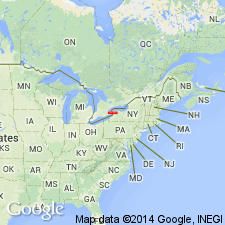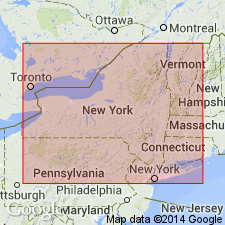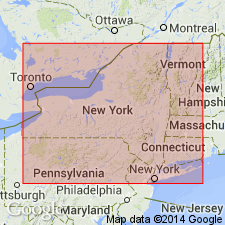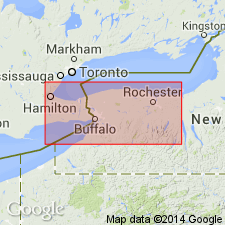
- Usage in publication:
-
- Rockway Dolomite Member
- Modifications:
-
- Named
- Dominant lithology:
-
- Dolomite
- AAPG geologic province:
-
- Appalachian basin
Summary:
Named the Rockway Dolomite Member of the Irondequoit Limestone in Ontario, CAN, and western NY for town of Rockway, Ontario, CAN. Consists of dense to compact fine-grained buff to gray dolomite which weathers buff. Mostly massive with a few gray shale breaks. Three to 15 inches of blocky brown shale at base. At most localities a 3- to 12-inch dolomite limestone bed occurs at top of member overlying a thin gray to brown shale. Thickness 12 feet a type locality. Occurs at base of formation. Overlies Merritton Limestone Member of Reynales Formation at its type locality. Overlies Hickory Corners Limestone Member of Reynales from Middleport, NY to Niagara Gorge. West of gorge disconformably overlies Merritton Limestone. At Woolverton Road west of Grimsby, overlies Thorold Sandstone disconformably. At Limehouse, Ontario, overlies Cabot Head Shale. Unit previously considered part of Reynales Formation. The Rockway is of Silurian age.
Source: GNU records (USGS DDS-6; Reston GNULEX).

- Usage in publication:
-
- Rockway Member
- Modifications:
-
- Revised
- AAPG geologic province:
-
- Appalachian basin
Summary:
Newly named Salmon Creek Bed, a thin quartz and phosphatic granule bed occurs at the base of the Irondequoit Limestone in western NY. The Salmon Creek is a widespread unit that is traceable across facies boundaries, occurring at the base of the Rockway Member in Niagara Co., at the base of the unnamed lower shaly member of the Irondequoit in Monroe Co., and at the base of the Dawes Formation in east-central NY. The Salmon Creek is Early and Middle Silurian (late Llandoverian and early Wenlockian).
Source: GNU records (USGS DDS-6; Reston GNULEX).

- Usage in publication:
-
- Rockway Member
- Modifications:
-
- Overview
- Dominant lithology:
-
- Dolomite
- Shale
- AAPG geologic province:
-
- Appalachian basin
Summary:
Rockway Member of Irondequoit Formation is a buff-weathering, argillaceous dolostone with thin shales. Shows prominent bands of argillaceous dolomite, ranging from a few cm to 0.5 m thick, which are interbedded with thin green shales. Underlies Model City Member (of Brett and others, in press). Extensive dolomitization has obscured the fossil contents of this unit. Large brachiopods are locally abundant, however, and dendroid graptolites, favositid corals and nautiloids are occasionally found. On basis of conodonts, Rockway is latest Llandoverian to earliest Wenlockian.
Source: GNU records (USGS DDS-6; Reston GNULEX).

- Usage in publication:
-
- Rockway Dolomite*
- Modifications:
-
- Revised
- AAPG geologic province:
-
- Appalachian basin
Summary:
The Rockway is raised in rank to the Rockway Dolomite of the Clinton Group in western NY because it can be separated from the Irondequoit Limestone by an unconformity. Consists of medium-gray, pale buff-weathering, thin- to medium-bedded, dolomitic wackestone separated by medium-gray, very thin dolomitic shales. The dolomitic shale interbeds thicken eastward from Niagara Co. In the Niagara region, the Rockway contains a distinctive succession of beds that includes a lower shale-rich zone that grades upward into medium-bedded dolomite, followed by a thick, blocky bed of dolomitic wackestone, overlain by thin to medium beds and a shaly zone, followed by an uppermost dolomicrite bed. Thickness is 12 feet at its type locality and is 6.6 to 9.2 feet in the subsurface of western NY. Well exposed in the Genesee River Gorge in Rochester, NY and in the Niagara River Gorge. Unconformably overlies the Williamson Shale or the Merritton Limestone, both of the Clinton Group, and underlies the Irondequoit Limestone of the Clinton Group by a minor unconformity. Eastward, the Rockway can be traced into the Dawes Formation in Madison Co., NY, and northwestward, it appears to grade laterally into the Lions Head Member of the Amabel Formation near Orangeville, Ont, CAN. The Rockway is of Early Silurian (latest Llandoverian and earliest Wenlockian) age based on conodont fauna.
Source: GNU records (USGS DDS-6; Reston GNULEX).
For more information, please contact Nancy Stamm, Geologic Names Committee Secretary.
Asterisk (*) indicates published by U.S. Geological Survey authors.
"No current usage" (†) implies that a name has been abandoned or has fallen into disuse. Former usage and, if known, replacement name given in parentheses ( ).
Slash (/) indicates name conflicts with nomenclatural guidelines (CSN, 1933; ACSN, 1961, 1970; NACSN, 1983, 2005, 2021). May be explained within brackets ([ ]).

